
Virginia Winter Birds: Three Woodpeckers
January 22nd, 2011
Three of the seven species of woodpeckers I saw on this trip:
1. Red-Bellied Woodpecker
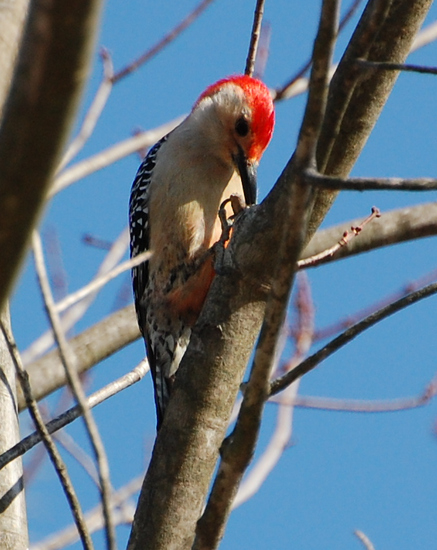
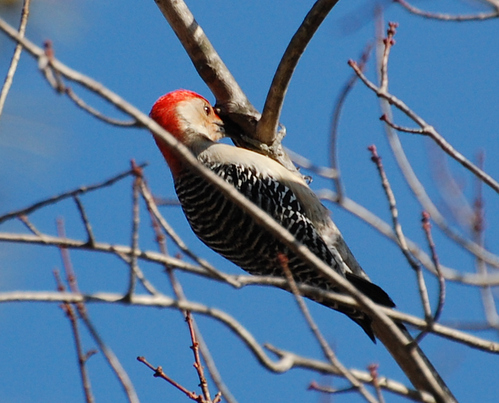
This is the single most common woodpecker in Virginia--at least judging by my experience. And I see them as often in the suburbs as in deep woods. Their call is a hoarse rattle that carries far and wide.
You can see a hint of this bird's eponymous feature in the first picture. I think it would be better named "Neon Woodpecker" though--the color of its red cap is of such a hue and brightness that it looks fluorescent to me.
2. Red-Headed Woodpecker
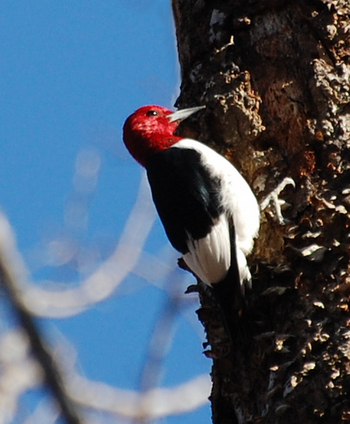
The Red-Headed Woodpecker is less common and is considered threatened in some areas. I rarely see them in the suburbs, but Pocahontas Park is a good place to find them, especially in winter. They love the tall mature trees there. Their habit of staying way up in said tall trees makes them tricky to photograph.
Like the previous species, this one is quite rare in Ottawa (we're at the northern tip of its range), but we do have one known breeding pair at Constance Bay.
3. Yellow-Bellied Sapsucker
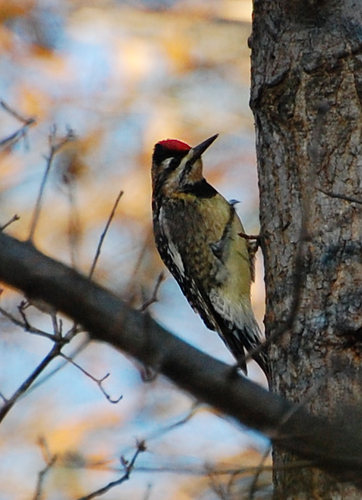
I've had several people tell me that they thought the Yellow-Bellied Sapsucker was a "joke" bird--a funny name that someone made up. (Says one website, "it sounds like an insult Yosemite Sam might sling at Bugs Bunny.") It's a real bird, and it really has a yellow belly (yellow-ish anyway), and it really eats sap. It's a type of woodpecker that uses its chisel bill to drill rows of small holes in trees, then it licks up the sap that wells out. The pictured bird is a female; males have a bright red chin in addition to the red crown.
Sapsuckers are skilled at getting sap to flow abundantly. (It's not as easy as it may sound.) And their skills are important to other birds too. Hummingbirds are attracted to sapsucker holes. They lick up the sweet sap for food to tide them over until the flowers start blooming.
Yellow-Bellied Sapsuckers are considered common breeders in our area, but I usually only see them in migration--they don't breed in central, easily-accessible places like Mud Lake. I expect the Gatineau is a good place to find them in summer. In Virginia in winter, though, they are downright suburbanites: I even saw one in the holly tree in my parents' front yard.
Virginia Winter Birds: OMG CUTE!
January 21st, 2011
...also known as the Winter Wren.
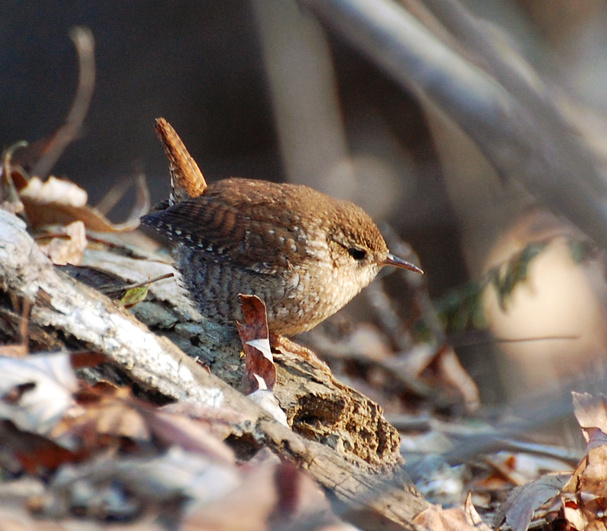
1680x1050 wallpaper
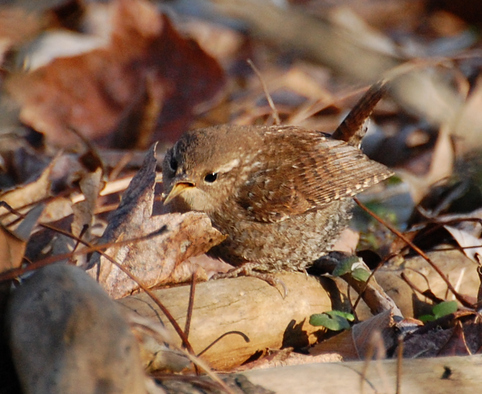
I found this guy foraging in leaf litter at Dutch Gap. He was unusually bold for a Winter Wren: a species that usually creeps, mouselike, through the undergrowth. This one repeatedly came out into plain view, practically at my feet, which afforded me the opportunity for several good photos.
The one I found at Pocahontas Park was more typical. Only after I sat quietly on the boardwalk for awhile did he become bold enough (or curious enough) to hop out into the open for a moment.
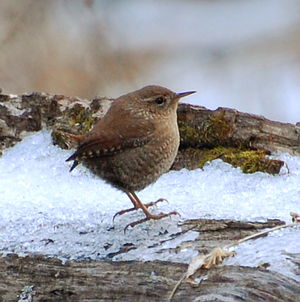
Virginia Winter Birds: Ring-Necked Duck
January 20th, 2011
Ring-Necked Ducks are among the most common winter denizens of the Dutch Gap marshes. This species breeds in the boreal forest and is a regular in Ottawa in fall migration, particularly at Mud Lake. It's an oddity: a diving duck that prefers shallow water.
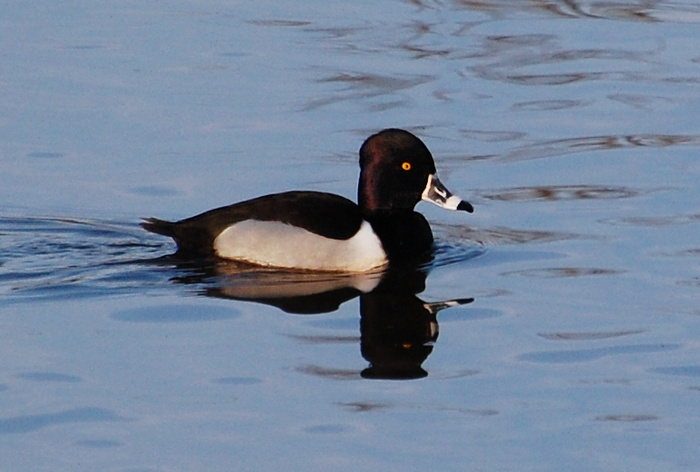
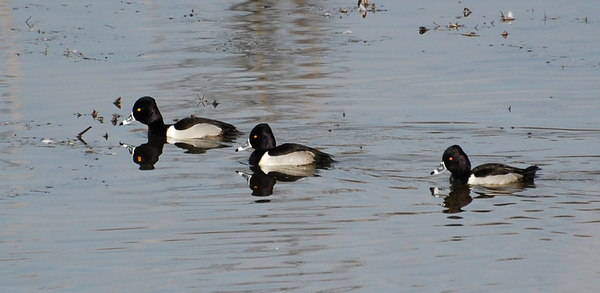
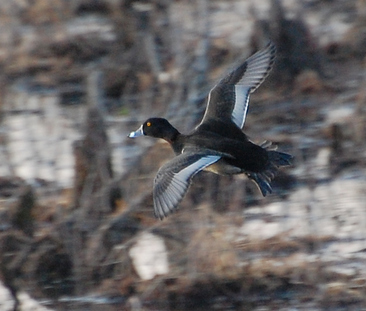
Surprise appearance at Dutch Gap
January 19th, 2011
I always make a trip to Dutch Gap when I visit Richmond. It's a conservation area on the James River. In winter, the hotspot is the marshes, where wintering waterfowl congregate, and Bald Eagles often perch in the branches above. There's no boardwalk (used to be, but they closed it down), but there are several points where you can stop your car and look out over the marsh from elevated platforms.
At the first lookout point, I saw some mystery ducks in the distance, swimming in and out of the vegetation. They had all-green heads like mallards, but their deep chestnut-colored flanks gave them away as something more exotic. I had no field guide on hand, but when I studied the pictures I took on my camera LCD and saw how long their bills were, I knew they could only be one thing: Northern Shovelers! A species I'd only ever seen at a huge distance away, in eclipse (drab brown) plumage, once. It's a rare species in Ottawa, at least at the places I frequent.
They were too far away for good photos. But we drove on to the next lookout point and struck gold: there was one swimming right out in the open!
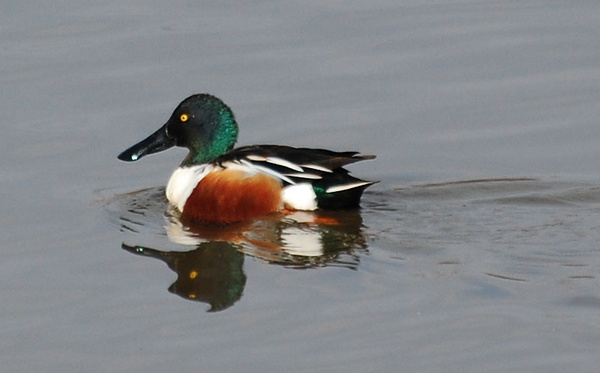
These ducks forage with their long, spoon-shaped bills lowered in the water. Comblike projections (lamellae) around the edges of the bill strain out small crustaceans, aquatic insects and other food. Unlike some dabbling ducks, they don't tip up.
It takes a profile shot to show just how long the bill is:

Escaping Ottawa Winter
January 12th, 2011
I know I'm not in Canada anymore when I get 30 species in one day in January!
I'm on vacation in Virginia this week, visiting my folks and birding away. The theme of the trip is shaping up to be "Red-Shouldered Hawks." I didn't realize what common winter residents they are here, or that many of the buteos I've previously dismissed as Red-Tailed Hawks were probably this species. I've seen three of them today, and photographed one. The lighting was not my friend--I would have had to go into someone's yard to get the sun in the right place for him, and I don't do that unless invited. But I did get a nice flight photo, even though it's mostly in silhouette. Hermit Thrush, Bluebird, Turkey Vulture, Mockingbird and others also presented for the camera.
With the storm past, we're having beautiful sunny weather here, and while my parents complain about the cold, I'm practically basking in what is to me autumn-like weather (5C, crisp and dry.) I expect to be outdoors a lot!
Odd Man Out
January 6th, 2011
Common Redpolls, those winteriest of winter birds, with their little crimson caps and delicate trills, have finally arrived at my local feeders! A small number of them have joined the goldfinches at the nyjer. They've been at Shirley's Bay for awhile, of course. But it's certainly nicer to be able to see them five minutes walk from my home.
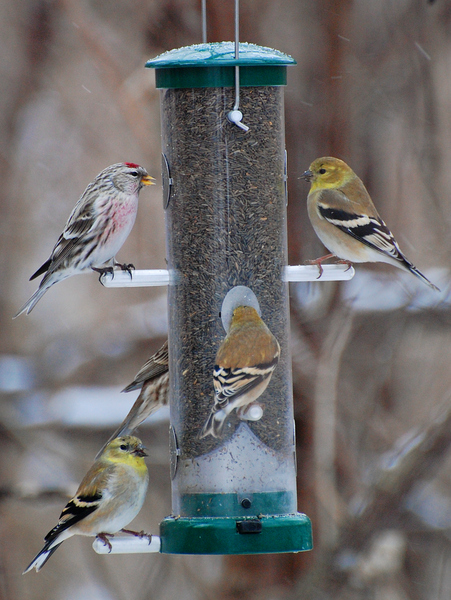
Close-up:

They're finally here!
December 26th, 2010
Today at the Shirley's Bay feeders, a sight I've eagerly awaited: a flock of redpolls!. It's a sight I hadn't enjoyed since February of 2009, since they didn't come south last winter. With them, some American Tree Sparrows, some goldfinches, other common birds, a female Pileated Woodpecker, and a great teeming gaggle of nature photographers. Passing overhead, large flocks of Bohemian Waxwings--wish fulfillment number two.
Sometime in the next few days I'm going back there with the camera and join the gaggle. Of course, with any luck, the redpolls will soon find their way to my own little nyjer feeder at Hurdman so I don't have to go across town to photograph them.
Chickadee
December 15th, 2010

A cloudy day at the Hurdman feeders
December 14th, 2010
Yesterday at the Hurdman feeders was the most frenetic I've seen...there or anywhere. Teeming masses of goldfinches, house finches and chickadees, whizzing back and forth, fighting over perches. Every perch on the nyjer feeder occupied. Woodpeckers and nuthatches stuffing themselves on suet. I filled the platform feeder almost to the brim in the morning; by afternoon, they'd emptied it. I guess they knew the weather was only going to get worse.

House Finch

American Goldfinch

Downy Woodpecker

White-Breasted Nuthatch

Black-Capped Chickadee and a very tenacious squirrel :-)
Ring-Billed Gull
November 30th, 2010

Another surprisingly handsome common bird. I like the bright red rings around their eyes.
|
